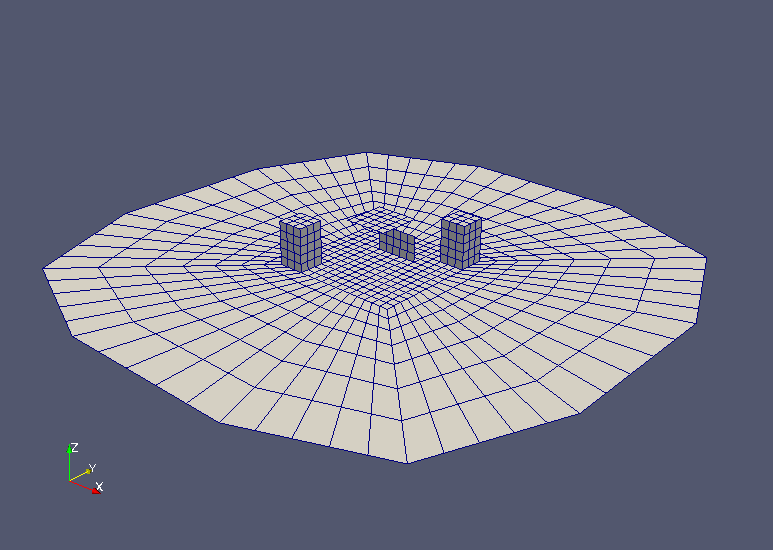Flame propagation in a space with obstacles
Case directory
$FOAM_TUTORIALS/combustion/PDRFoam/flamePropagationWithObstacles
Summary
The flame propagation in an area with obstacles is calculated based on the PDR (Porosity/Distributed Resistance) model. Specifically, the b-Ξ two-equation model is used.
 Model geometry
Model geometry
 Model geometry near the obstacle (red: obstacle, green: surface area with connected front and back)
Model geometry near the obstacle (red: obstacle, green: surface area with connected front and back)
In this calculation, variables including the following are used:
- betav: porosity of the volume
- Lobs: Average diameter of the obstacles in the cell (m)
- Aw: Surface area of the obstacle per unit volume (1/m)
- CR: Drag tensor (1/m)
- CT: Turbulence generation parameter (1/m)
- Nv: Number of obstacles in the cell per unit volume (m-2)
- nsv: Tensor. The diagonal component of this tensor represents the number to be subtracted from Nv to obtain the number of obstacles crossed by the flow in each direction.
The PDRFoam specific settings are defined in the file "PDRProperties" in the directory "constant", and the ignition positions are defined in the file "combustionProperties" in the same directory.
The meshes are as follows, and the number of mesh is 8115.
 Meshes
Meshes
 Meshes (ground and obstacle surface)
Meshes (ground and obstacle surface)
 Meshes (cross-sectional surface)
Meshes (cross-sectional surface)
The calculation results are as follows. The figures are rendered by volume rendering.
 Temperature on XZ-plane at 0.03 sec (T)
Temperature on XZ-plane at 0.03 sec (T)
 Temperature on XY-plane at 0.05 sec (T)
Temperature on XY-plane at 0.05 sec (T)
We can see that the temperature propagation is blocked by obstacles.
Commands
cd flamePropagationWithObstacles
rm -rf 0
cp -r 0.orig 0
blockMesh
changeDictionary
topoSet
PDRMesh -overwrite
PDRFoam
paraFoam
Calculation time
6 minutes 12.8 seconds *Single, Inter(R) Core(TM) i7-2600 CPU @ 3.40GHz 3.40GHz
Reference
- OpenFOAM-4.x/applications/solvers/combustion/PDRFoam/PDRFoam.C
- "Numerical Study of the b-Ξ Flame Wrinkling Combustion Model in Oracles Test Rig", J. Aerosp. Technol. Manag. vol.7 no.4 São José dos Campos Oct./Dec. 2015, Guilherme Henrique Santos, Wladimyr Dourado(PDF)